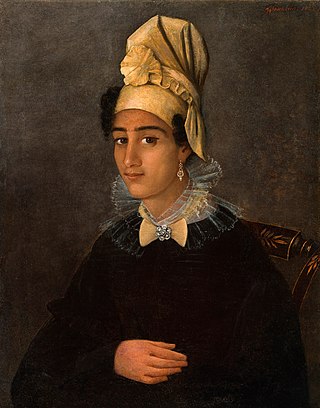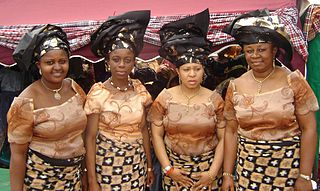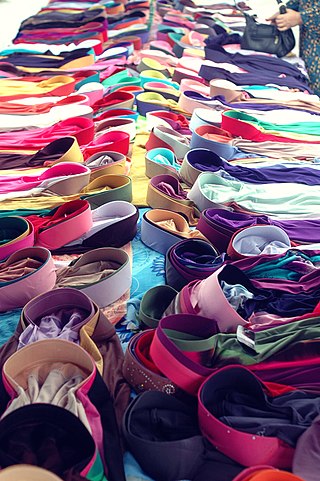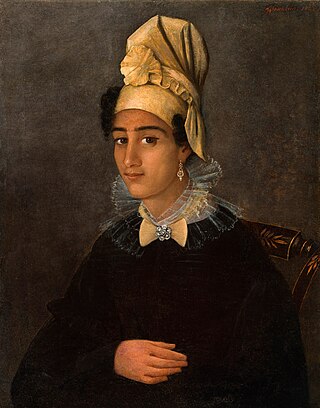
Dreadlocks, also known as dreads or locs, are a hairstyle made of rope-like strands of hair. This is done by not combing the hair and allowing it to mat naturally or by twisting it manually. Over time, the hair will form tight braids or ringlets.

A turban is a type of headwear based on cloth winding. Featuring many variations, it is worn as customary headwear by people of various cultures. Communities with prominent turban-wearing traditions can be found in the Indian subcontinent, Southeast Asia, the Middle East, the Balkans, the Caucasus, Central Asia, North Africa, West Africa, East Africa, and amongst some Turkic peoples in Russia.

A scarf is a long piece of fabric that is worn on or around the neck, shoulders, or head. A scarf is used for warmth, sun protection, cleanliness, fashion, religious reasons, or to show support for a sports club or team. Scarves can be made from materials including wool, linen, silk, and cotton. It is a common type of neckwear and a perennial accessory.

A headscarf is a scarf covering most or all of the top of a person's, usually women's, hair and head, leaving the face uncovered. A headscarf is formed of a triangular cloth or a square cloth folded into a triangle, with which the head is covered.

A tignon is a type of headcovering—a large piece of material tied or wrapped around the head to form a kind of turban that somewhat resembles the West African gele. It was worn by Creole women of African descent in Louisiana beginning in the Spanish colonial period, and continuing to a lesser extent to the present day.

The wrapper, lappa, or pagne is a colorful garment widely worn in West Africa by both men and women. It has formal and informal versions and varies from simple draped clothing to fully tailored ensembles. The formality of the wrapper depends on the fabric used to create or design it.

The tudong is a style of headscarf, worn as interpretation of the Islamic hijab, prevalent amongst many Muslim women in the Malay-speaking world; Indonesia, Brunei, Malaysia, and Singapore. Today, the tudong forms part of the standard dress code for many offices in Indonesia and Malaysia, as well as in school uniforms and formal occasions. Though initially considered a conservative form of dress, it is worn today by most moderate Muslim women in Malaysia and Indonesia.

According to halacha, married Jewish women are expected to cover their hair when in the presence of men other than their husband or close family members. Such covering is common practice among Orthodox Jewish women.

Christian head covering, also known as Christian veiling, is the traditional practice of women covering their head in a variety of Christian denominations. Some Christian women wear the head covering in public worship and during private prayer at home, while others believe women should wear head coverings at all times. Among Oriental and Eastern Orthodox Churches, certain theologians likewise teach that it is "expected of all women to be covered not only during liturgical periods of prayer, but at all times, for this was their honor and sign of authority given by our Lord", while others have held that headcovering should at least be done during prayer and worship. Genesis 24:65 records the veil as a feminine emblem of modesty. Manuals of early Christianity, including the Didascalia Apostolorum and Pædagogus, instructed that a headcovering must be worn by women during prayer and worship as well as when outside the home. When Saint Paul commanded women to be veiled in 1 Corinthians, the surrounding pagan Greek women did not wear headcoverings; as such, the practice of Christian headcovering was countercultural in the Apostolic Era, being a biblical ordinance rather than a cultural tradition. The style of headcovering varies by region, though Apostolic Tradition specifies an "opaque cloth, not with a veil of thin linen".

Aso oke hat, known as fila gobi in the Yoruba language, is a soft hat traditionally worn by the Yoruba people of Western Africa. It is made of hand-woven aso oke fabric, cotton, velvet, or damask. They are usually lined with cotton, but can be unlined if crafted to be worn for a single event.

Aso oke fabric, is a hand-woven cloth that came from the ijebu people of Western Nigeria. Usually woven by men and women, the fabric is used to make men's gowns, called agbada and hats, called fila, as well as Yoruba women's wrappers called Iro and a Yoruba women's blouse called Buba and a gown called Komole, as well as an head tie, called gele and so on.

Various styles of head coverings, most notably the khimar, hijab, chador, niqab, paranja, yashmak, tudong, shayla, safseri, carşaf, haik, dupatta, boshiya and burqa, are worn by Muslim women around the world, where the practice varies from mandatory to optional or restricted in different majority Muslim and non-Muslim countries.

Headgear, headwear, or headdress is any element of clothing which is worn on one's head, including hats, helmets, turbans and many other types. Headgear is worn for many purposes, including protection against the elements, decoration, or for religious or cultural reasons, including social conventions.
Segun Gele is a Nigerian born make-up artist and entrepreneur based in United States. His work was featured on CNN for his ability to tie the gele in flamboyant style, a fashion attire of significant importance to the Yoruba, Nigerian and West African women's fashion culture.

The fashion industry in Nigeria plays an important cultural role and contributes significantly to the country's economy. Clothing incorporates a variety of colours, fabrics, and embellishments. Many of the component cultures of Nigeria wear styles that are characteristic of their tribal society and customs. Nigeria produces fashionable textiles and finished garments and has designers who have achieved international recognition.

The tignon law was a 1786 law enacted by the Spanish Governor of Louisiana Esteban Rodríguez Miró that forced black women to wear a tignon headscarf. The law was intended to halt plaçage unions and tie freed black women to those who were enslaved, but the women who followed the law have been described as turning the headdress into a "mark of distinction".

Waist beads is a type of jewelry worn around the waist or on the hips originating from West Africa, they are traditionally worn by women as a symbol of beauty, sexuality, femininity, fertility, well-being or maturity.

Gele is a traditional head tie native to Yoruba people of Nigeria, Benin and Togo. The gele comes in specific shapes and designs. Gele is worn with other Yoruba women's outfits, like Iro ati buba, Komole and Asoebi.

Yoruba clothing is the traditional clothing worn by people of the Yoruba ethnic group in parts of Nigeria, Benin and Togo in a region called Yorubaland. The clothing reflects the rich culture, history and aesthetic preferences of the Yoruba people.
Aso Olona is a traditional Yoruba textile known for its intricate geometric patterns and cultural significance, particularly among the Ijebu subgroup. The term "Aso Olona" translates to "cloth with patterns" in the Yoruba language. Aso Olona is an handwoven fabrics that can come with motifs like the chameleon.


















